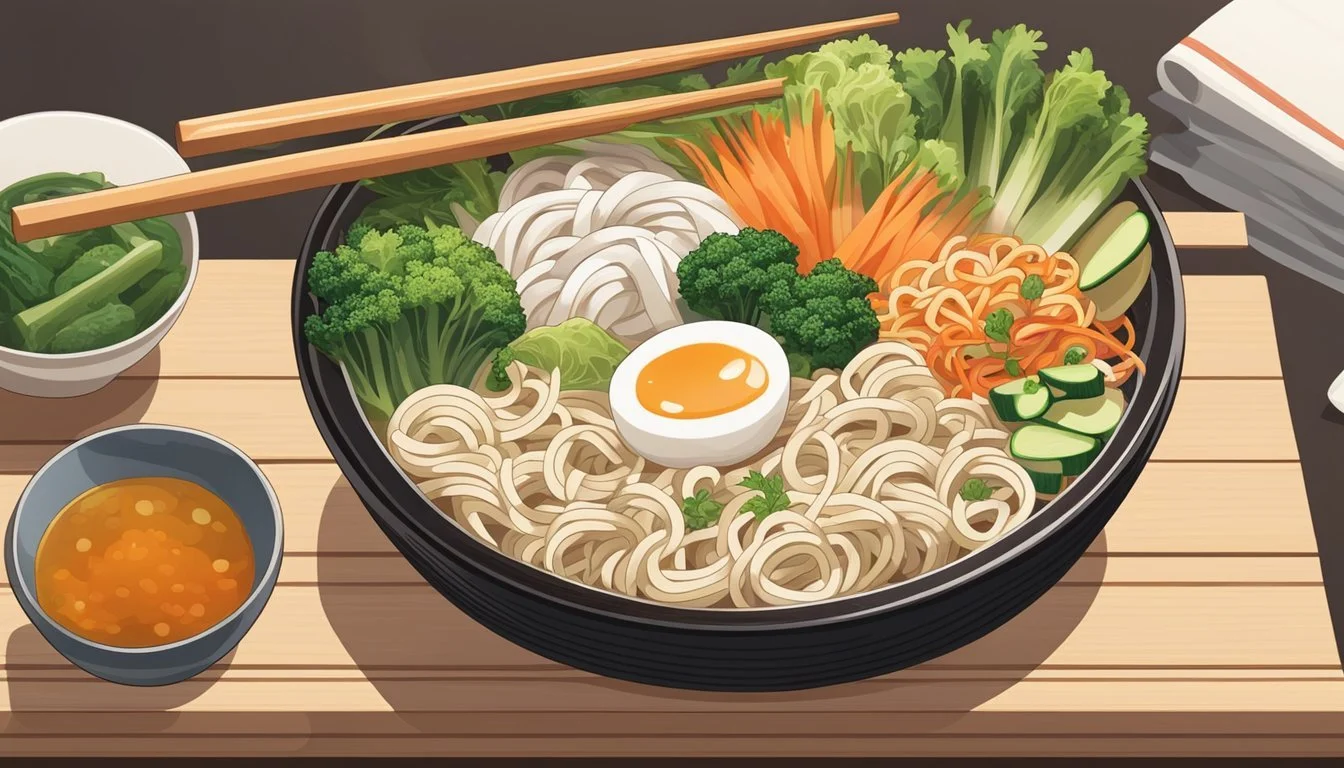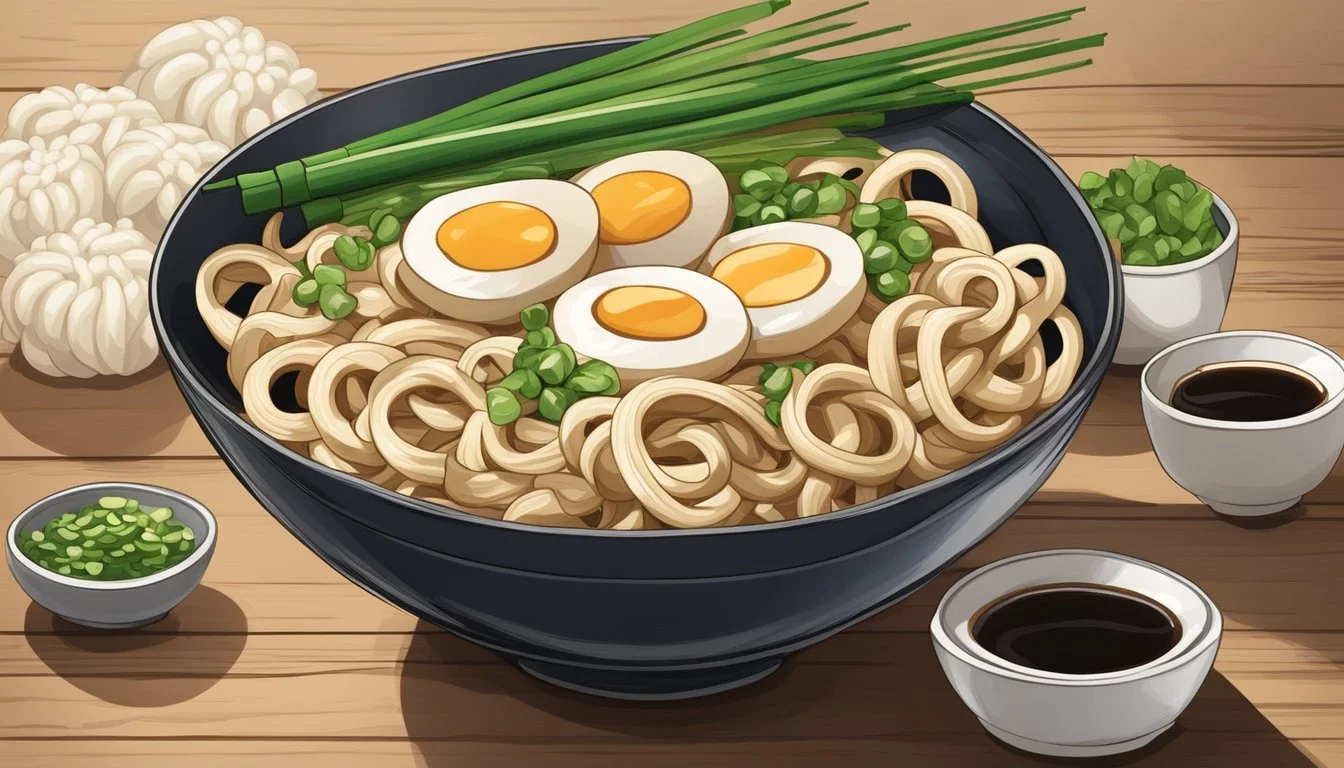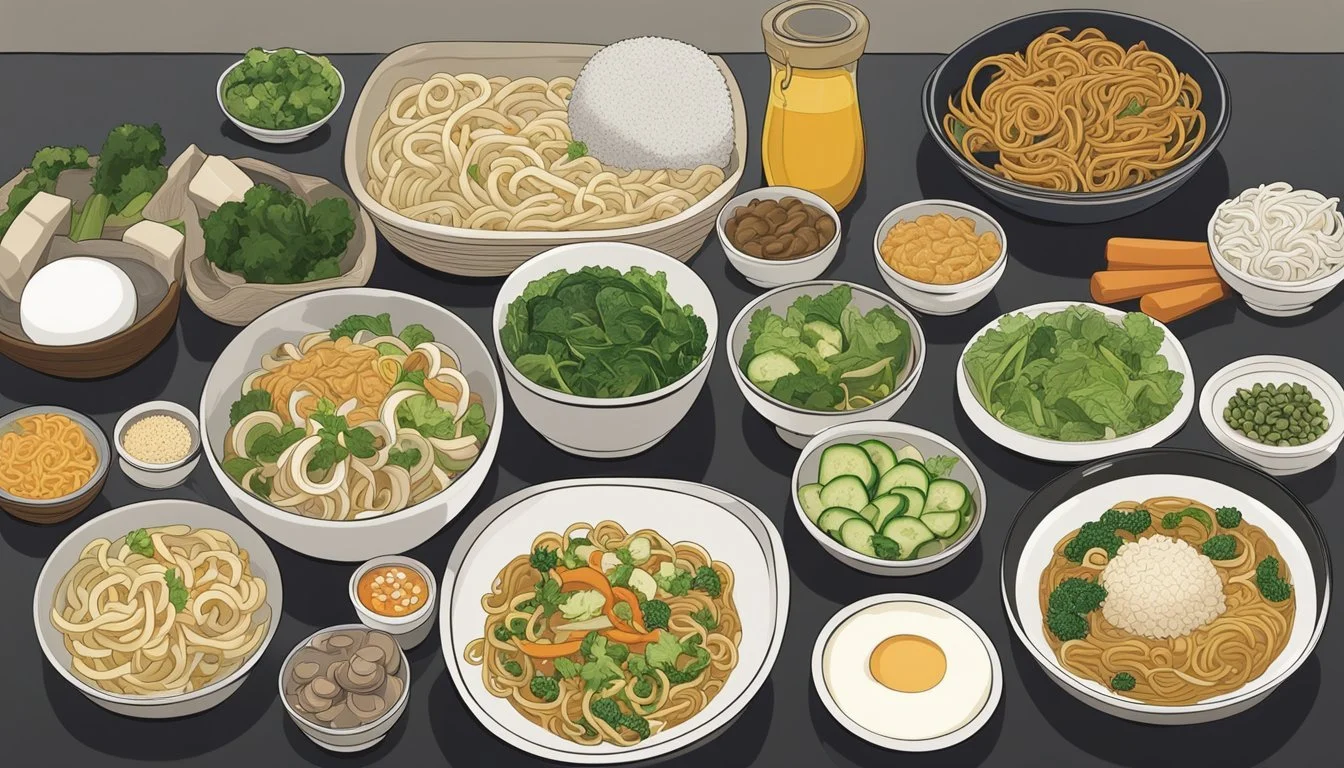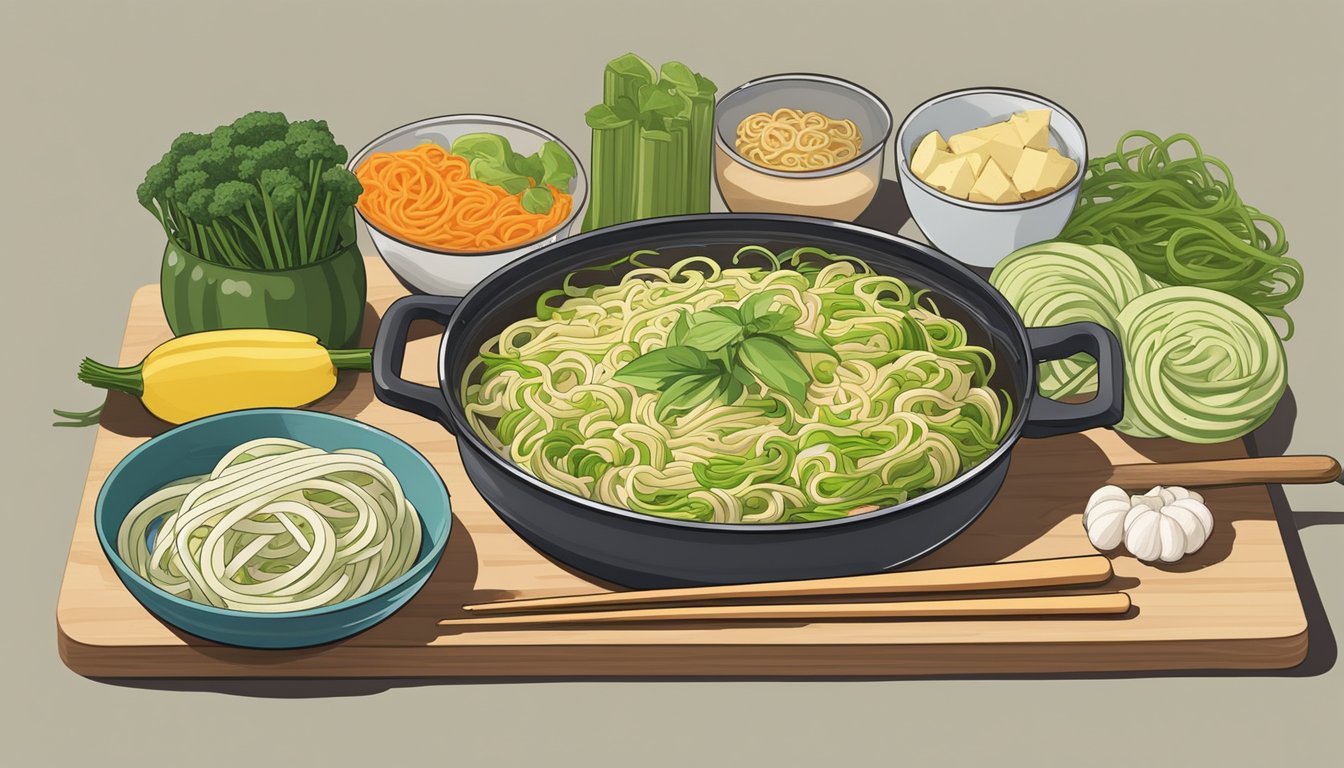Udon Noodles Substitutes
Top Alternatives for Your Japanese Dishes
Udon noodles, thick and chewy wheat flour noodles, are a staple in Japanese Cuisine. Udon's versatility is showcased in various dishes, including soups, stir-fries, and cold salads. The noodle's distinctive texture and satisfying bite make it a favorite among noodle enthusiasts. In its traditional form, udon offers a unique culinary experience with its simplistic yet robust flavor profile that complements a myriad of ingredients.
However, finding the perfect substitute for udon noodles can be essential for those with dietary restrictions, or when this particular noodle is unavailable. Substituting udon noodles doesn't mean compromising on taste or texture. There is a range of alternatives that can mimic the property of udon and adapt well to the flavors and structures of the recipes that typically call for them. Substitutes such as rice noodles, Chinese egg noodles, shirataki noodles, and soba noodles can be adapted to fit into the dishes normally reserved for udon, ensuring that the essence of the dish remains intact.
Understanding Udon Noodles
Udon noodles stand out in Asian cuisine, particularly within Japanese food culture, for their distinctive chewy texture and versatility in dishes, from soups to stir-fries. This section delves into the essential aspects of udon noodles, from their characteristics to their usefulness in the kitchen.
Characteristics of Udon Noodles
Udon noodles are thick, round, and chewy, primarily made from wheat flour. Their substantial size and satisfying bite make them easily distinguishable from other Asian noodles. Traditional udon is often fresh and exhibits a soft yet elastic texture that has become synonymous with comfort food in Japanese cooking.
Culinary Uses of Udon Noodles
Udon noodles feature prominently in a variety of Japanese dishes. They are commonly served in a mildly flavored broth as kake udon, or can be enjoyed in hot or cold preparations. Udon also adapts well to noodle salads and stir-fry dishes, absorbing flavors and providing a fulfilling base.
Nutritional Profile of Udon Noodles
Udon's primary ingredient, wheat flour, offers carbs and calories, making these noodles a hearty food choice. While not particularly high in protein or fiber, udon can be part of a healthy diet when consumed in moderation. The presence of certain vitamins also contributes to the nutritional value, though one should be mindful of blood sugar levels, as with any carbohydrate-heavy food, particularly for those monitoring conditions like type 2 diabetes.
Nutrient Value per Serving Calories Varies Carbs Varies Protein Low Fiber Low Vitamins Present
Udon in Traditional and Modern Dishes
Udon's adaptability has secured its place in both traditional and modern cuisine. Whether in simple broths or elaborate stir-fries, the noodles' chewy quality brings a contrast to dishes that is both desirable and unique. Udon is particularly celebrated in Asian cuisine for its balance of texture and flavor.
Availability and Shopping Tips
Fresh udon noodles can usually be found in Asian markets, while dried versions are commonly stocked in supermarkets. When shopping for udon, one might consider whether the dish in question will benefit from the subtle flavors and textures of fresh noodles or the convenience of dried. In cases of non-availability, knowing suitable substitutes can be invaluable for achieving a close approximation in taste and texture.
Common Udon Noodles Substitutes
When seeking alternatives to udon noodles, it's important to consider factors such as texture, flavor, and how well the substitute integrates with various broths and sauces. The following substitutes offer a range of options that cater to different dietary needs and culinary preferences.
Soba Noodles
Soba noodles are made from buckwheat flour and provide a nutty flavor suitable for cold dishes in Japanese cuisine. Though thinner than udon, soba cooks quickly, typically in about 3 minutes, and offers a robust taste that pairs well with traditional Japanese broths.
Spaghetti and Italian Pastas
Traditional Italian pastas like spaghetti or linguine can stand in for udon in a pinch. They're best suited for recipes with a heavier, tomato-based sauce or in soups where the broth can cling to the pasta. To mimic udon's chewy texture, cook the pasta just until al dente.
Asian Wheat Noodles
Asian wheat noodles, like ramen, lo mein, and chow mein, are all viable substitutes for udon. Ramen noodles share a similar wheat base and flavor profile, while lo mein or chow mein offer a texture that works well in stir-fries and oilier dishes due to their ability to absorb sauces.
Rice-Based Noodles
Rice noodles, including variants like vermicelli, are a light substitute, perfect for salads and stir-fries. Made from rice flour, these noodles come in different sizes and can be soaked or boiled. Their delicate texture is a contrast to udon's chewiness but provides a gluten-free option.
Specialty Gluten-Free Options
For those requiring gluten-free alternatives, noodles made from buckwheat or beans can replicate the heartiness of udon while keeping the dish safe for those with sensitivities. These noodle types may require specific cooking times to achieve the desired texture.
Vegetable Noodles
Vegetable noodles, or "zoodles," made from zucchini, carrot, or other vegetables using a spiralizer, offer a health-conscious, low-carb substitute for udon. They maintain their shape when cooked briefly and absorb flavors from broths and sauces, contributing to a lighter, nutritious dish.
Creating Homemade Udon Alternatives
Substituting udon noodles in recipes can be a creative and personalized process. This section guides the reader through crafting alternatives with different ingredients to match dietary preferences and health considerations, while preserving the essence of traditional udon noodles' culinary roles.
Using Basic Ingredients
To replicate udon's mild flavor and chewy texture with basic pantry items, one can mix all-purpose wheat flour, water, and a pinch of salt. Achieving the right consistency involves resting the dough and rolling it out thinly before slicing into strands. Cook these in boiling water for 12-13 minutes and rinse with cold water.
Gluten-Free Udon Style Noodles
Rice flour and potato starch can be combined to create gluten-free noodles with a mild flavor similar to udon. This alternative is suitable for those with gluten intolerance or celiac disease. Mix equal parts of rice flour and potato starch with water and a touch of baking soda to mimic the alkaline environment akin to traditional udon.
Making Low-Calorie Udon Substitutes
For individuals looking for fewer calories or weight loss, shirataki noodles, crafted from Konjac yam, present an excellent low-calorie udon alternative. Their firm and spongy texture absorbs flavors from soups and broths effectively, while significantly reducing calorie intake.
Innovative Udon Substitutes
Vegetable noodles, such as spaghetti squash or zoodles (zucchini noodles), offer an innovative twist to traditional udon. They can be used in stir-fries and soups, bringing a fresh flavor profile and richness in nutrients. Both options are significantly lower in calories and carbs, while still satisfying the craving for a noodle-like texture.
Adapting Recipes for Udon Substitutes
When using alternative noodles in udon recipes, adjustments in spices and cooking time may be required. For instance, bolder spices can enhance the flavor profile of more neutral substitutes like spaghetti squash. Meanwhile, most udon alternatives require less cooking time than traditional udon noodles, so it's advisable to taste test for doneness periodically.
Selecting the Best Substitute for Your Dish
When looking for the best substitute for udon noodles, consider the flavor, texture, nutritional content, and any dietary restrictions. This section explores the various options ensuring that your selection complements your culinary creation.
Considering Flavor Profiles
Every noodle substitute brings a unique flavor profile to a dish. For a substitute that closely matches udon's mild flavor, hiyamugi noodles are an excellent choice. If an earthy or nutty flavor is desired, soba noodles, made from buckwheat flour, provide that complexity and are a suitable choice for traditional Japanese recipes.
Matching Texture and Consistency
Udon noodles are known for their thick and chewy texture. To replicate this, one might opt for hiyamugi noodles or ramen noodles, as both are wheat-based and offer a similar chewiness. These substitutes come close to udon's satisfying bite, essential for soups and stir-fries. For textures that are slippery and heft in the dish, shirataki noodles, made from konjac yam, can be considered due to their firm yet spongy consistency.
Nutritional Considerations
Udon noodles are relatively high in carbohydrates and calories. Alternatives such as soba noodles are not only high in fiber but also contain protein. Those looking to reduce carbs might consider shirataki noodles for their low-carb benefit. It is essential to compare the nutrition labels to ensure the substitute aligns with health goals, such as weight loss or managing type 2 diabetes.
Dietary Restrictions and Allergies
When adapting a recipe for specific dietary needs, identifying a suitable noodle alternative is critical. Rice noodles are a popular gluten-free option, and they come in various forms that can suit a dish's requirements. For those seeking vegan substitutes, most Asian-style noodles like soba and shirataki fit this category. These options allow individuals to enjoy their favorite dishes without compromising on dietary restrictions.
Pairing Substitutes With Different Dishes
Selecting the right noodle substitute for udon can enhance the dish, respecting its original flavor and texture profile. When pairing substitutes with different dishes, consider the consistency of the noodles and the dish’s characteristics, whether they're served in soups, stir-fries, or as cold salads.
Soba for Cold Dishes
Soba noodles, made from buckwheat, are best suited for cold dishes such as noodle salads. Their earthy flavor complements a variety of vinaigrettes and sauces typically used in cold preparations. The difference in taste between soba and udon is notable but can add a delightful twist to the dish.
Stir-Fry Options
For stir-fry dishes, thicker noodles such as Chinese egg noodles serve as an excellent substitute. They retain a similar texture and slipperiness as udon, lending themselves well to the high heat and quick cooking method of stir-frying. Other stir-fry suitable options include:
Thick wonton noodles: Offer a good bite and stand up to robust flavors.
Shirataki noodles: Their unique, firm yet spongy consistency absorbs stir-fry sauces effectively.
Choosing Noodles for Soups and Broths
In soups and broths, noodles that can hold up without becoming overly soft are essential. Spaghetti, when cooked al dente, can be a worthwhile stand-in for udon in brothy dishes like kake udon. Key points to remember include:
Spaghetti: Ideal for its versatility and similar thickness.
In summary, the right noodle substitute can maintain the integrity of the dish's texture and flavor, whether it's a refreshing cold salad, a savory stir-fry, or a comforting soup or broth.
Tips and Tricks for Cooking Noodle Substitutes
When seeking to recreate the unique qualities of udon noodles, it's essential to consider the cooking times, techniques, and seasonings. Correct sourcing and storage can also significantly enhance the end result.
Cooking Times and Techniques
For substitutes like soba or rice noodles, cooking times will vary. A general rule is to boil soba noodles for 4-5 minutes and rice noodles for just 2-3 minutes. Always start with a pot of boiling salted water to bring out the subtle flavors of the noodles. Do not overlook the importance of cold rinsing to stop the cooking process and remove excess starch.
Fresh noodles: Boil for 1-2 minutes
Dried noodles: Boil according to the package; typically longer than fresh
Enhancing Substitutes With Seasonings
Incorporating seasonings such as salt and Asian spices can drastically improve the taste of noodle substitutes. To emulate the mild flavor of udon, add a dash of salt to the boiling water and consider a light seasoning of soy sauce or fish sauce post-cooking.
Add alkaline water to the dough of fresh noodles for a chewier texture.
Use spices sparingly to complement, not overpower, the main dish.
Sourcing Ingredients From Specialized Stores
Asian markets are likely to carry a variety of noodles that can be used as substitutes for udon. These stores often provide both fresh and dried options. Supermarkets might have limited selections, so exploring Asian markets could lead to finding the best ingredients that can achieve a slippery texture and authentic flavor.
Fresh noodles: Typically found in refrigerated sections
Dried noodles: Located in the international aisle
Maximizing Flavor and Texture
The key to mimicking udon's chewy texture and slippery surface is in the preparation. For a slippery texture reminiscent of udon, briefly sauté noodles
Conclusion
Finding a suitable replacement for udon noodles depends largely on one's dietary preferences and the specific dish being prepared. Those seeking a low-carb alternative may consider shirataki noodles, as they are made from Konjac yam, which is rich in fiber and has a firm, spongy texture that absorbs flavors well. For individuals interested in a more traditional noodle experience without the gluten, soba noodles serve as an excellent substitute. While distinct in taste, they can be used in similar applications to udon noodles, such as soups and cold dishes.
For home cooks who enjoy making noodles from scratch, preparing a homemade dough and cutting it into strands offers the most customized substitute. This method provides the freedom to adjust the thickness and width of the noodles to closely mimic the characteristics of udon.
When convenience and cost are primary concerns, ramen noodles become a preferable option. They cook quickly, typically within 2 to 3 minutes, and their texture is firm enough to hold up in the hearty broths and stir-fries where udon is traditionally used.
It is important to recognize the variations in flavor and nutritional content when selecting a substitute. Each option brings a unique element to the dish, and some experimentation is often required to find the perfect match. Remaining adaptable and open to trying different alternatives will lead to the most satisfying culinary results.





